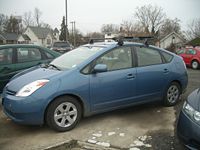An Application of Electromechanical Energy Conversion: Hybrid Electric Vehicles


Conversion of electrical energy to mechanical energy and vice versa allows for many very useful applications. As a result of today’s energy conscious society, these applications are being used more widely. One of the most conspicuous applications of electromechanical energy conversion is hybrid electric vehicles. These vehicles differ from conventional cars in that they are driven by both a combustion engine and at least one electric motor. This motor is usually a brushless DC motor, specifically an interior permanent magnet motor<ref> Hybrid electric vehicle </ref>. These are are similar to a garden variety induction motor, but very strong rare earth metals make this motor more efficient. An advantage of an electric motor is that it produces its maximum torque almost instantly. Consequently, a smaller combustion engine can be used, and less fuel is consumed. Electrical energy stored to power the electric motor[s] is typically acquired through regenerative braking. This process converts the vehicle’s kinetic energy into electrical energy by using an electric motor as a generator<ref> Regenerative brake </ref>. On most hybrid electric vehicles, the motor/generator stores the energy in a battery (typically a 200-350 volt nickel metal hydride pack<ref> The Hybrid Car Battery: A Definitive Guide </ref>). The way electrical energy is captured and spent varies depending on the drivetrain structure. The most popular layouts are parallel hybrid and series-parallel hybrid.
Parallel Hybrid Layout
A parallel hybrid has both an internal combustion engine and an electric motor connected to the transmission. Typically, the electric motor is connected to the transmission via a differential. Since a differential is used, mechanically, the torques supplied by the motor and the engine must be the same, and the speeds of the motors must sum to the speed of the transaxle. With this layout, the electric motor not only converts electrical energy into mechanical energy, but it also captures mechanical energy (during regenerative braking) and converts it into stored electrical energy. A common example of this layout is the Honda Integrated Motor Assist, employed on the Civic Hybrid and Insight.
Series-Parallel Hybrid Layout
.
A series-parallel layout is quite different from the parallel layout. It has two motor generators. Energy can be converted to either mechanical or electrical energy by either motor generator. The most common series-parallel hybrid system is the Hybrid Synergy Drive. In the iteration of this system employed on the Toyota Prius, the two motor generators and the internal combustion engine are linked via a planetary gear set<ref> Hybrid Synergy Drive </ref>. This gear set divides the power between the motors and the engine. A computer decides whether the electric motors should produce or store energy and how the gear set will divide the power based on the vehicle’s time-specific power necessity.
The Future of Hybrid Electric Vehicles
The next generation of this technology will be plug-in hybrids. In addition to all of the functionalities described above, these vehicles will have batteries that can be connected to an external electric power source<ref> Plug-in hybrid </ref>. As a result, they can be propelled solely by their electric motor[s] for a considerable distance. This allows the internal combustion engine to remain completely off for some period of time.
References
<references/>
Reviewed By
Contributors
Readers
Wesley Brown


